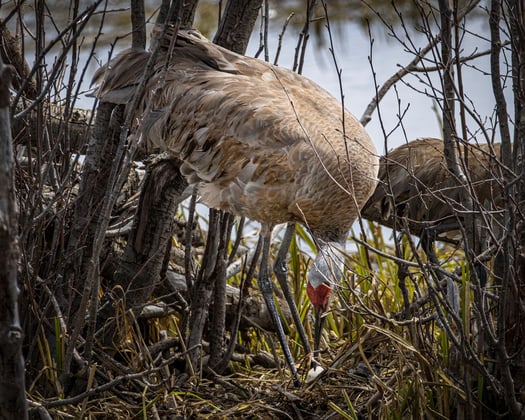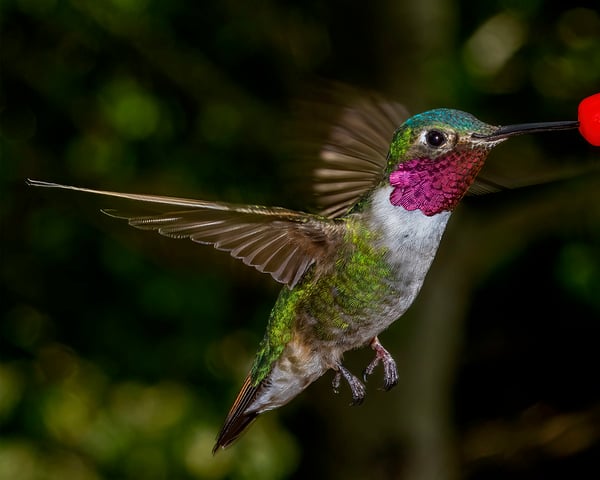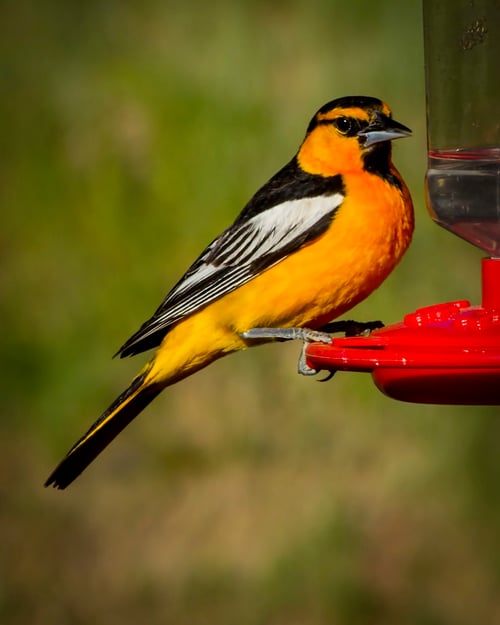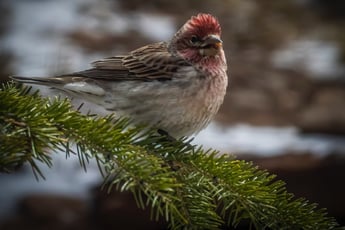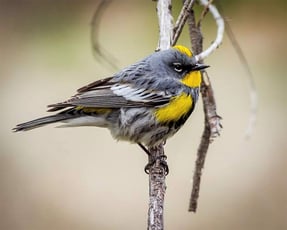Text and Photos by Rick Spitzer,
For the Eagle County Wildlife Roundtable
Many people have noticed a decline in the number of birds in the environment in Eagle County. Others see a decline at their feeders. There are not as many ducks in the ponds as in past years, and the forest seems quieter. There is no current data that can prove or support these observations, but many people are noticing something significant. There is not one reason for this possible decline in birds, but many.
One of the biggest issues is climate change. The National Audubon Society estimates that “two-thirds of North American birds are at increasing risk of extinction from global temperature rise.” What is the actual impact of climate change?
Broad tailed hummingbirds migrate to Colorado from winter grounds in southern Mexico or Guatemala. They may get here and find the food supply diminished due to drought and other factors.
Birds have some of the longest migrations of any animal on the planet. As they travel, they are dependent on food resources and quality habitat to survive that trip. The bird’s habitats are changing. Forest fires, pollution, human disturbances, industrial contamination, hunting, light pollution, and others may impact available food and places to rest as they make their journey. Climate change is impacting the bird’s range with areas of drought, lower water levels, higher temperatures, seasons that start earlier, more severe weather and weather with greater severity.
Even when the birds arrive at their destinations, they may face any or all these issues in their summer or winter habitats. A false spring with unseasonably warm, mid-winter days “trick” plants into flowering early. When the birds arrive, foods they depend on, nectar or seeds, may no longer be available which may force birds to abandon their normal range to find suitable habitat.
It is vital that we stabilize carbon emissions to hold down warming to 1.5°C above pre-industrial levels. Colorado does have an action plan to reduce greenhouse-gas pollution. Many cities and some utilities aim for 100-percent zero-carbon electricity by 2050. We all need to step up.

Finding one dead bird, like this yellow rumped warbler, may not be an issue. Finding large numbers of dead birds is.
There are many changes that are a direct result of human activity and not related to climate change. Urbanization is something we all witness, and we are causing it. More people in an area means there is a need for more services which creates a demand for more people. Population increases wipe out habitat used by birds for food, cover, and nesting sites. Good planning by governments can help to ameliorate issues.
Avian influenza is caused by a virus that infects birds. It is most common in waterfowl and shorebirds. These birds can carry the virus without showing any signs of disease. Infected birds shed bird flu virus through their saliva, mucous and feces. A new strain of avian influenza causes more severe disease and a higher mortality in some bird species, particularly waterfowl and domestic poultry. Clean bird feeders regularly and if you suspect avian flu, contact the State Veterinarian's office.
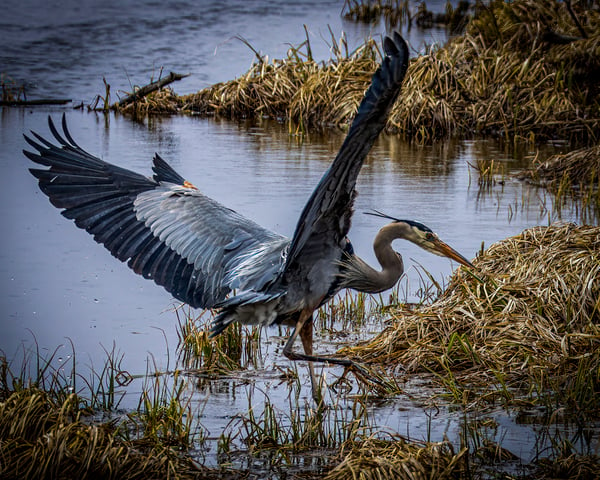
Birds like this great blue heron, rely on foods in riparian areas. Fertilizers and insecticides may harm that food supply.
Another issue is fertilizers. We use fertilizer to increase crop yields and improve the quality of lawn grass and landscaping. The incorrect application of fertilizer products can be toxic for birds and other wildlife that use those areas. Some solid fertilizers when mixed in with seeds on the ground may be ingested as the birds eat the seed, and some of those products can cause serious harm. Birds also ingest grit and store it in their gizzards to help break down hard-to-digest foods. The birds may unknowingly ingest the fertilizer with this grit.
Use only as much fertilizer as needed. Water sparingly after applying the product. This causes the fertilizer to dissolve and sink into the ground to the roots. That makes the fertilizer less likely to run off and less available for the birds.
Insecticides have a significant impact on the environment. Many will last for years in the environment and have a high toxicity to many animals, including birds, bees, and fish. Many pollinators, like bees, are dying off which will have long-term impacts to ecosystems as well as our food security.
Pesticides known as neonicotinoids (“neonics” for short) are a major issue. They are one of the deadliest pesticides ever created. These kinds of pesticides not only kill the pest, but they will also kill butterflies, bees, and other wildlife. Neonics are considered nearly 50 times more deadly to insect life.
Neonics are “systemic” pesticides. Plants absorb the pesticide as it grows which makes all parts of the plant (nectar, pollen, leaves, stems, and fruit) toxic. 95 percent of the product ends up in the soil. Neonics remain active for years and are washed into other areas by rain or irrigation and carried long distances to contaminate new soil, plant life, and water supplies. The U.S. Geological Survey found neonic pollution in at least half of the streams it sampled nationwide. Neonics have been linked to bird losses, fisheries collapse, and birth defects in mammals.
Reduce the use of insecticides and find products that do not impact other organisms and have a short life in the environment.
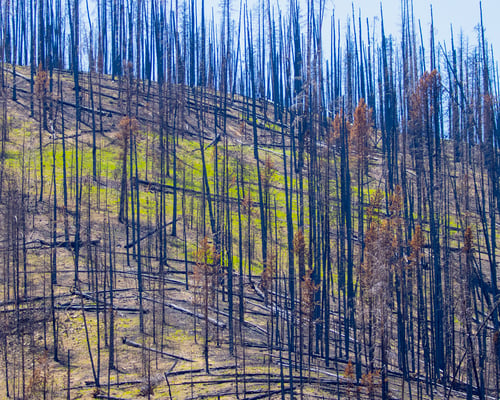
Extreme wildfire may wipe out all vegetation in an area. Seeds, insects, and other things birds rely on may be eliminated.
Wildfire is becoming more common. Wildfire historically has been part of our environment, but recently they have become more frequent and more intense. Some of these fires are so intense that they kill close to 100% of the trees. The practice of fire suppression has created centurys worth of accumulated fuel and a warming, drying climate exacerbates the problem. These huge fires can have a major impact on wildlife, and birds. Birds may not be directly killed as they can fly away.
Low flying birds may be killed from smoke inhalation and exhaustion. The smoke and toxic gases from these fires can cause lung damage which increases the potential of lethal respiratory infections. The toxic gases from wildfires caused a huge die off of migratory birds during 2020. Such findings suggest potential population-level impacts that remain poorly understood.
Good forest management and caution on the side of the public can prevent wildfires.
This Bullocks oriole at a feeder may be exposed to diseases brought in by other birds. Clean feeders help prevent avian flu.
Millions of birds migrate across North America every spring and fall. Most of these birds travel at night, using the magnetic fields of the earth. Some use the moon and stars to find their way. Birds flying at night over brightly lit cities have a problem. The skyglow prohibits the birds from seeing stars and may lure them toward urban areas. They become confused and may end up circling and hitting buildings.
Some research shows that white light LEDs (4,000 Kelvin bulbs) are a serious risk to the environment and to human health. Warm light LED (<3,000 Kelvin) alternatives, better lighting design with shielded light fixtures, aiming light down, and reducing lighting levels can also be beneficial. Warm light LEDs also have the International Dark Sky Association’s Fixture Seal of Approval.
Lighting up the night may also impact highly complex ecosystems that rely on timed circadian rhythms (light/dark cycles). It can impact wildlife mating, migration, flowering, hunting, hibernation, plant budding and flowering, leaf drop, and many other issues.
Turn off all unnecessary overnight lighting. Replace fixtures with shielded fixtures and warm light LEDs. That will also save money and energy, reduce our carbon footprint, and protect our view of the stars!
Many people, and maybe you, are bird lovers. Watching them in our yards or in the woods, seeing them at bird feeders, and hearing them is something many enjoy. Some create life lists and travel far and wide to add birds to their lists. Hopefully we will be able to do things that will help stabilize and increase bird populations for their benefit and our enjoyment.
======================================
The Eagle County Community Wildlife Roundtable is a collaborative partnership with the White River National Forest, Colorado Parks and Wildlife, Bureau of Land Management, local government entities, community members, and citizen scientists. The purpose of the Eagle County Community Wildlife Roundtable is to gather a group of diverse stakeholders in the valley to understand and address issues facing wildlife populations. Together we will identify a shared vision and realistic actions that the community can rally around to support wildlife. We want to leverage diverse values, creativity, and resources to move toward positive action.
======================================

